Learn how to troubleshoot AC problems in this guide from 1st Class Heat & Air. We offer 10% off AC repair and have the skills to get the job done right!
HVAC Options for Old Houses
There has always been conflict and difference of opinion about making changes to an old house, and for good reason. There is a delicate balance between preserving the historical integrity of a home and making upgrades to support the demands of modern life. One of the most important considerations in this regard is how to heat and cool the house.
If you have an older home and are researching the best heating and cooling options for old houses, you’ve come to the right place. Keep reading for a list of considerations to keep in mind!
1st Class Heat & Air is always available to provide you with a heating & cooling survey of your old home. Give us a call now at 972-673-0408 to request an appointment.
What You Need to Know About Older Homes & Energy Efficiency
Before jumping on to how to cool or heat your old house, you should first focus on how to make your home more energy efficient. Old houses have significant structural differences from newer homes, which are built by modern energy efficiency standards. While the average new home today may have things like tightly sealed doors and windows, weather-stripping, and sophisticated ventilation systems to control indoor temperatures and humidity levels, older homes won’t have these systems in place. This means that older homes have more problems with air leakage, translating to heat loss during the winter and cold air loss during the summer. This, in turn, means more work for your heating and cooling systems and more money spent on trying to control your indoor temperature. Correcting energy efficiency issues can help you save!
Here are some things you can do to improve the energy efficiency of your old house:
- Install a smart meter. Installing a smart meter in your home will help you keep track of your energy consumption.
- Update lights. Swap out traditional light bulbs with energy-efficient and long-lasting LED bulbs. Not only do they consume very little energy and last up to 25,000 hours, they also provide the added bonus of emitting less heat than older bulbs that range from 100 watts to 1000 watts.
- Get a smart thermostat. Smart thermostats are programmable, which means you can customize your heating and cooling preferences for different hours of the day without having to constantly change the settings. For example, you can set the temperature lower during the hours you’re away at work, which means you’ll save more on the energy that would have been wasted before on heating or cooling an empty house.
- Consider renewable energy. Using renewable energy to generate electricity will help you save money on your electricity bills, but it may not fit the aesthetic of your home if you’re trying to preserve its historical integrity. If this isn’t a problem for you, solar panels are a great option.
- Address your chimney. The chimneys in houses built decades ago were built with different requirements than today, which unfortunately means that in addition to a number of safety concerns, they are also a prime place for heat/energy loss. Always keep the damper closed when the chimney is not in use. You may also wish to consider hiring a chimney professional for an inspection and to go over additional options on how to keep energy loss to a minimum.
How to Cool an Old House
Most old houses were built even before the concept of air conditioners entered the market. As a result, they aren’t compatible with modern air conditioning needs, like a duct system to circulate air throughout the home. If your old house doesn’t have air ducts, don’t worry; you still have options!
If you are looking for the most economical way to cool your old house, consider the following:
High-Velocity HVAC Systems
Even if you wanted to install ductwork for central air conditioning in an old house, it simply may not have the space to accommodate it. While this may seem like an obstacle, it may actually be a blessing in disguise, because there is a better and more cost-effective solution. Rather than spending several thousand dollars trying to add conventional air ducts for central air conditioning, you can go with a high-velocity HVAC system instead. High-velocity HVAC systems use mini-ducts that are considerably smaller than the standard ones. Since they are small, they can be easily installed around the house. They even have smaller vents, which means fewer disruptions to the interior decoration of your house.
Ductless Mini-Split Systems
Another potential solution to solve the ductwork problem is to get a ductless mini-split HVAC system. As the name suggests, they do not require ductwork installation. Instead, mini-splits utilize two main components: an outdoor compressor and an indoor air-handling unit, which are linked together by a conduit housing the power cable, refrigerant tubing, suction tubing, and a condensate drain. This system offers balanced conditioned air around the house as well as zoning capabilities that can help you save money.
How to Heat an Old House
As with air conditioning, a lack of air ducts is the biggest consideration when choosing ways to heat an old house. If you’re in this situation, here are some heating systems that will work for your older home:
Mini-Duct Forced Air System
If you’re looking for an easy HVAC retrofit for old houses. the mini-duct forced air system might be for you. Also known as a small-duct high-velocity HVAC system, a mini-duct air distribution system, or a Unico system, it’s one of the best and most versatile solutions for heating an older home. Other benefits include whisper-quiet operation and unobtrusive outlet vents that won’t disrupt your home’s aesthetics.
Radiant Heat
Radiant heating is a concept that became popular post-World War II. Unlike forced air heating systems like furnaces or heat pumps, radiant heating systems involve the use of hot water pipes that run underneath your flooring. Radiant heat is often found in old houses, but they may be prone to leaks. To avoid problems, you should have your system routinely maintained by a qualified heating professional. If you ever see evidence of a leak, call for service quickly to keep flooring damage to a minimum.
Some things are better left for the professionals! Contact 1st Class Heat & Air and get a professionally trained & certified HVAC technician to come out and guide you on the best heating and cooling options for your old house!

